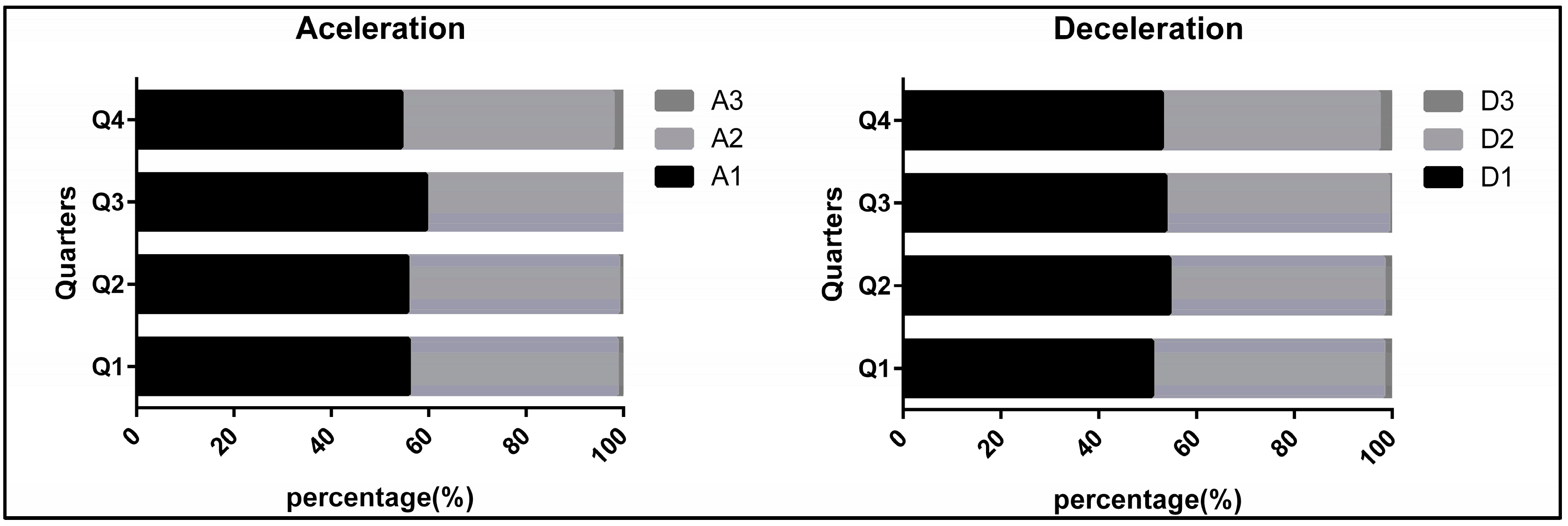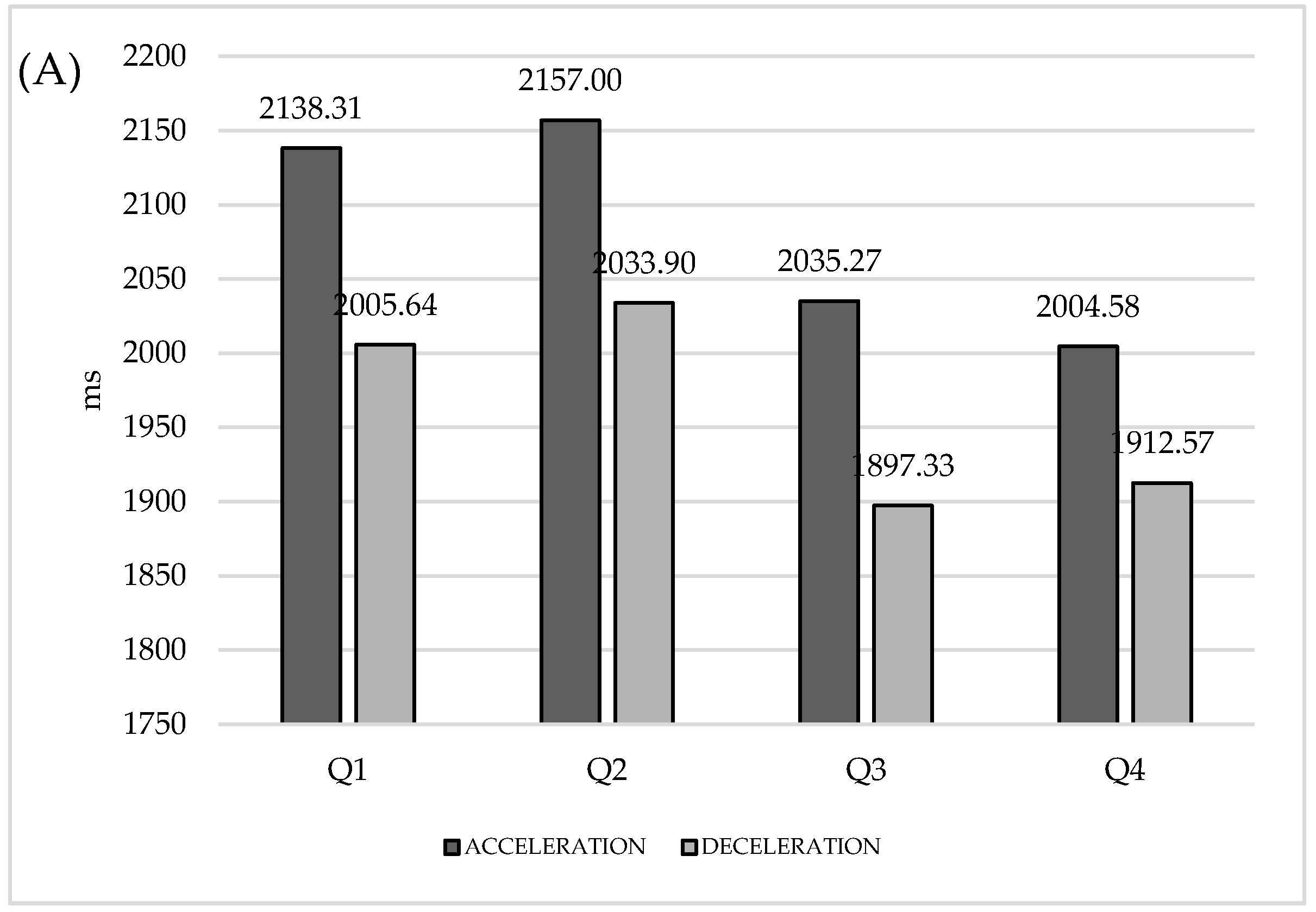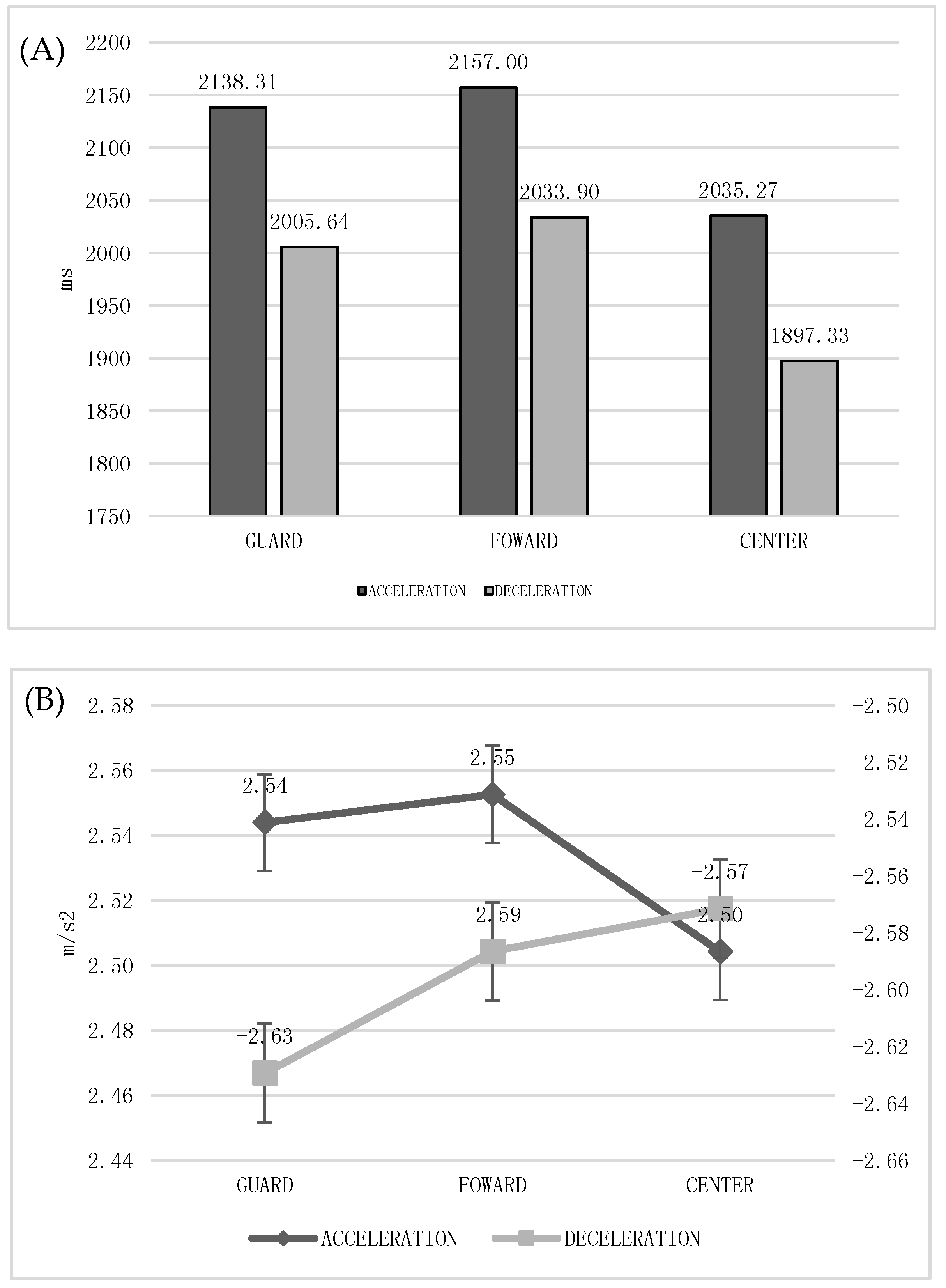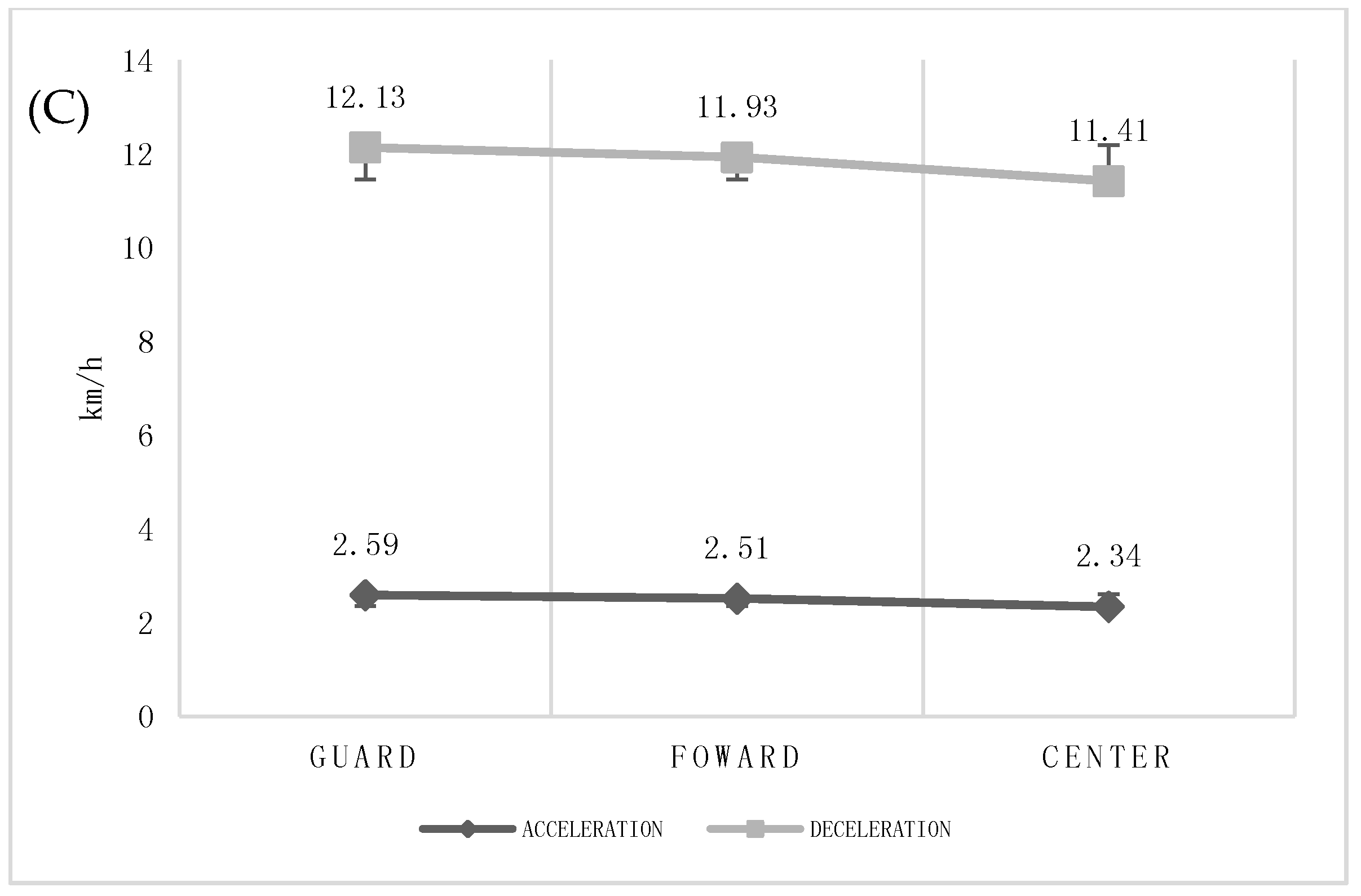The Acceleration and Deceleration Profiles of U-18 Women’s Basketball Players during Competitive Matches
Abstract
:1. Introduction
2. Materials and Methods
2.1. Participants
2.2. Measurements
2.3. Design and Procedures
2.4. Statistical Analysis
3. Results
3.1. Results by Quarter
3.2. Results by Playing Positions
4. Discussion
5. Conclusions
Author Contributions
Funding
Acknowledgments
Conflicts of Interest
References
- Abdelkrim, N.B.; El Fazaa, S.; El Ati, J. Time–motion analysis and physiological data of elite under-19-year-old basketball players during competition. Br. J. Sports Med. 2007, 41, 69–75. [Google Scholar] [CrossRef] [PubMed]
- Narazaki, K.; Berg, K.; Stergiou, N.; Chen, B. Physiological demands of competitive basketball. Scand. J. Med. Sci. Sports. 2009, 19, 425–432. [Google Scholar] [CrossRef] [PubMed]
- Ostojic, S.M.; Mazic, S.; Dikic, N. Profiling in basketball: Physical and physiological characteristics of elite players. J. Strength Cond. Res. 2006, 20, 740–744. [Google Scholar] [CrossRef] [PubMed]
- Sampaio, J.; Ibañez Godoy, S.J.; Gómez Ruano, M.Á.; Lorenzo Calvo, A.; Ortega Toro, E. Game location influences basketball players performance across playing positions. Int. J. Sport Psychol. 2008, 39, 43–50. [Google Scholar]
- Delextrat, A.; Badiella, A.; Saavedra, V.; Matthew, D.; Schelling, X.; Torres-Ronda, L. Match activity demands of elite Spanish female basketball players by playing position. Int. J. Perform. Anal. Sport 2015, 15, 687–703. [Google Scholar] [CrossRef]
- Frencken, W.G.; Lemmink, K.A.; Delleman, N.J. Soccer-specific accuracy and validity of the local position measurement (LPM) system. J. Sci. Med. Sport 2010, 13, 641–645. [Google Scholar] [CrossRef] [PubMed]
- Stevens, T.G.; de Ruiter, C.J.; van Niel, C.; van de Rhee, R.; Beek, P.J.; Savelsbergh, G.J. Measuring acceleration and deceleration in soccer-specific movements using a local position measurement (LPM) system. Int. J. Sports Physiol. Perform. 2014, 9, 446–456. [Google Scholar] [CrossRef] [PubMed]
- Bastida Castillo, A.; Gómez Carmona, C.D.; De la Cruz Sánchez, E.; Pino Ortega, J. Accuracy, intra-and inter-unit reliability, and comparison between GPS and UWB-based position-tracking systems used for time–motion analyses in soccer. Eur. J. Sport Sci. 2018, 18, 450–457. [Google Scholar] [CrossRef]
- Lovell, T.W.; Sirotic, A.C.; Impellizzeri, F.M.; Coutts, A.J. Factors affecting perception of effort (session rating of perceived exertion) during rugby league training. Int. J. Sports Physiol. Perform. 2013, 8, 62–69. [Google Scholar] [CrossRef]
- Trost, S.G.; Loprinzi, P.D.; Moore, R.; Pfeiffer, K.A. Comparison of accelerometer cut points for predicting activity intensity in youth. Med. Sci. Sports Exerc. 2011, 43, 1360–1368. [Google Scholar] [CrossRef]
- Montgomery, P.G.; Pyne, D.B.; Minahan, C.L. The physical and physiological demands of basketball training and competition. Int. J. Sport Physiol. 2010, 5, 75–86. [Google Scholar]
- Field, A. Discovering Statistics Using SPSS; Sage Publications: Thousand Oaks, CA, USA, 2009. [Google Scholar]
- Thalheimer, W.; Cook, S. How to calculate effect sizes from published research: A simplified methodology. Work-Learn. Res. 2002, 1, 1–9. [Google Scholar]
- Batterham, A.M.; Hopkins, W.G. Making meaningful inferences about magnitudes. Int. J. Sport Physiol. 2006, 1, 50–57. [Google Scholar] [CrossRef]
- Gaudino, P.; Alberti, G.; Laia, F.M. Estimated metabolic and mechanical demands during different small-sided games in elite soccer players. Hum. Mov. Sci. 2014, 36, 123–133. [Google Scholar] [CrossRef] [PubMed]
- Arruda, A.F.; Carling, C.; Zanetti, V.; Aoki, M.S.; Coutts, A.J.; Moreira, A. Effects of a very congested match schedule on body-load impacts, accelerations, and running measures in youth soccer players. Int. J. Sports Physiol. Perform. 2015, 10, 248–252. [Google Scholar] [CrossRef]
- Matthew, D.; Delextrat, A. Heart rate, blood lactate concentration, and time-motion analysis of female basketball players during competition. J. Sports Sci. 2009, 27, 813–821. [Google Scholar] [CrossRef]
- Scanlan, A.T.; Dascombe, B.J.; Reaburn, P.; Dalbo, V.J. The physiological and activity demands experienced by Australian female basketball players during competition. J. Sci. Med. Sport 2012, 15, 341–347. [Google Scholar] [CrossRef]
- Abdelkrim, N.B.; Castagna, C.; Jabri, I.; Battikh, T.; El Fazaa, S.; El Ati, J. Activity profile and physiological requirements of junior elite basketball players in relation to aerobic-anaerobic fitness. J. Strength Cond. Res. 2010, 24, 2330–2342. [Google Scholar] [CrossRef]
- García, J.; Ibáñez, S.; De Santos, R.M.; Leite, N.; Sampaio, J. Identifying basketball performance indicators in regular season and playoff games. J. Hum. Kinet. 2013, 36, 161–168. [Google Scholar] [CrossRef]
- García-Rubio, J.; Gómez, M.Á.; Cañadas, M.; Ibáñez, S.J. Offensive Rating-Time coordination dynamics in basketball. Complex systems theory applied to Basketball. Int. J. Perform. Anal. Sport 2015, 15, 513–526. [Google Scholar] [CrossRef]
- Marcelino, R.; Sampaio, J.; Mesquita, I. Attack and serve performances according to the match period and quality of opposition in elite volleyball matches. J. Strength Cond. Res. 2012, 26, 3385–3391. [Google Scholar] [CrossRef]
- Sampaio, J.; McGarry, T.; Calleja-González, J.; Sáiz, S.J.; i del Alcázar, X.S.; Balciunas, M. Exploring game performance in the National Basketball Association using player tracking data. PLoS ONE 2015, 10, e0132894. [Google Scholar] [CrossRef] [PubMed]
- Torres-Ronda, L.; Ric, A.; Llabres-Torres, I.; de las Heras, B.; i del Alcazar, X.S. Position-dependent cardiovascular response and time-motion analysis during training drills and friendly matches in elite male basketball players. J. Strength Cond. Res. 2016, 30, 60–70. [Google Scholar] [CrossRef] [PubMed]
- Nikolaidis, P.; Calleja-González, J.; Padulo, J. The effect of age on positional differences in anthropometry, body composition, physique and anaerobic power of elite basketball players. Sport Sci. Health 2014, 10, 225–233. [Google Scholar] [CrossRef]
- Reina, M.; García-Rubio, J.; Feu, S.; Báñez, S.J. Training and Competition Load Monitoring and Analysis of Women’s Amateur Basketball by Playing Position: Approach Study. Front. Psychol. 2019, 9, 2689. [Google Scholar] [CrossRef] [PubMed]
- Tee, J.C.; Lambert, M.I.; Coopoo, Y. GPS comparison of training activities and game demands of professional rugby union. Int. J. Sports Sci. Coach. 2016, 11, 200–211. [Google Scholar] [CrossRef]
- Schelling, X.; Torres, L. Accelerometer load profiles for basketball-specific drills in elite players. J. Sports Sci. Med. 2016, 15, 585. [Google Scholar]
- Howatson, G.; Milak, A. Exercise-induced muscle damage following a bout of sport specific repeated sprints. J. Strength Cond. Res. 2009, 23, 2419–2424. [Google Scholar] [CrossRef] [PubMed]







| Measures | p | ES | %mean; ±95%CL | Magnitude | |||
|---|---|---|---|---|---|---|---|
| ACC | Duration (ms) | Q1–Q2 | 0.893 | 0.003 | −0.13 ± 2 | 26.2 | Possible |
| Q1–Q3 | 0.001 | 0.122 | 3.8 ± 2.2 | 99.8 | Almost certain | ||
| Q1–Q4 | 0.001 | 0.148 | 4.6 ± 2.7 | 99.8 | Almost certain | ||
| Q2–Q3 | 0.001 | 0.126 | 3.9 ± 2.3 | 99.8 | Almost certain | ||
| Q2–Q4 | 0.001 | 0.152 | 4.8 ± 2.8 | 99.8 | Almost certain | ||
| Q3–Q4 | 0.368 | 0.029 | 0.9 ± 2 | 65.5 | Possible | ||
| Max Acc (m/s2) | Q1–Q2 | 0.868 | 0.006 | −0.17 ± 2 | 25.2 | Possible | |
| Q1–Q3 | 0.003 | 0.096 | 3 ± 2 | 99.3 | Almost certain | ||
| Q1–Q4 | 0.061 | 0.061 | −1.9 ± 2 | 0.9 | Uncertain | ||
| Q2–Q3 | 0.002 | 0.099 | 3.1 ± 2 | 99.5 | Almost certain | ||
| Q2–Q4 | 0.088 | 0.054 | −1.7 ± 2 | 1.4 | Very improbable | ||
| Q3–Q4 | 0.001 | 0.151 | −4.7 ± 2.8 | 0.0 | Uncertain | ||
| Start SPD (km/h) | Q1–Q2 | 0.707 | 0.012 | 0.38 ± 2 | 45.1 | Possible | |
| Q1–Q3 | 0.003 | 0.090 | 3 ± 2 | 99.3 | Almost certain | ||
| Q1–Q4 | 0.064 | 0.060 | 1.9 ± 2 | 91.2 | Probable | ||
| Q2–Q3 | 0.01 | 0.080 | 2.6 ± 2 | 98.1 | Very probable | ||
| Q2–Q4 | 0.142 | 0.048 | 1.5 ± 2 | 83.3 | Probable | ||
| Q3–Q4 | 0.271 | 0.033 | −1.1 ± 2 | 5.5 | Very improbable | ||
| DEC | Duration (ms) | Q1–Q2 | 0.484 | 0.023 | −0.7 ± 2 | 11.5 | Improbable |
| Q1–Q3 | 0.001 | 0.121 | 3.7 ± 2.2 | 99.8 | Almost certain | ||
| Q1–Q4 | 0.003 | 0.095 | 2.9 ±1.9 | 99.3 | Almost certain | ||
| Q2–Q3 | 0.001 | 0.142 | 4.3 ± 2.6 | 99.8 | Almost certain | ||
| Q2–Q4 | 0.001 | 0.116 | 3.6 ± 2.1 | 99.8 | Almost certain | ||
| Q3–Q4 | 0.509 | 0.022 | 3.4 ± 10 | 71.3 | Possible | ||
| Max Acc (m/s2) | Q1–Q2 | 0.006 | 0.09 | −2.8 ± 2 | 0.1 | Uncertain | |
| Q1–Q3 | 0.001 | 0.115 | −3.3 ± 1.9 | 0.0 | Uncertain | ||
| Q1–Q4 | 0.621 | 0.017 | −0.5 ±2 | 16.0 | Improbable | ||
| Q2–Q3 | 0.692 | 0.019 | −0.4 ± 2 | 18.5 | Improbable | ||
| Q2–Q4 | 0.025 | 0.072 | 2.2 ± 2 | 95.9 | Probable | ||
| Q3–Q4 | 0.007 | 0.094 | 2.7 ± 2 | 98.6 | Almost certain | ||
| Start SPD (km/h) | Q1–Q2 | 0.101 | 0.053 | 1.6 ± 2 | 87.3 | Probable | |
| Q1–Q3 | 0.001 | 0.192 | 5.8 ± 3.4 | 99.9 | Almost certain | ||
| Q1–Q4 | 0.001 | 0.161 | 4.9 ± 2.9 | 99.8 | Almost certain | ||
| Q2–Q3 | 0.001 | 0.139 | 4.2 ± 2.5 | 99.8 | Almost certain | ||
| Q2–Q4 | 0.001 | 0.109 | 3.4 ± 2 | 99.7 | Almost certain | ||
| Q3–Q4 | 0.424 | 0.026 | −0.8 ± 2 | 9.7 | Improbable | ||
| Measures | p | ES | %mean; 95%CL | Magnitude | |||
|---|---|---|---|---|---|---|---|
| ACC | Duration (ms) | G–F | 0.059 | 0.050 | –1.9 ± 2 | 0.8 | Uncertain |
| G–C | 0.001 | 0.110 | –3.7 ± 2.2 | 0.0 | Uncertain | ||
| F–C | 0.012 | 0.070 | –2.5 ± 2 | 0.1 | Uncertain | ||
| Max Acc (m/s2) | G–F | 0.001 | 0.220 | 5.8 ± 3.5 | 99.9 | Almost certain | |
| G–C | 0.001 | 0.180 | 3.8 ± 2.3 | 99.8 | Almost certain | ||
| F–C | 0.705 | 0.009 | –0.38 ± 2 | 19.0 | Improbable | ||
| Start SPD (km/h) | G–F | 0.001 | 0.170 | 6 ± 3.6 | 99.9 | Almost certain | |
| G–C | 0.001 | 0.130 | 4.2 ± 2.5 | 99.8 | Almost certain | ||
| F–C | 0.418 | 0.023 | –0.81 ± 2 | 9.5 | Improbable | ||
| DEC | Duration (ms) | G–F | 0.149 | 0.038 | –1.4 ± 2 | 2.6 | Very improbable |
| G–C | 0.001 | 0.115 | –3.6 ± 2.1 | 0.0 | Uncertain | ||
| F–C | 0.004 | 0.083 | –2.6 ± 1.8 | 0.0 | Uncertain | ||
| Max Acc (m/s2) | G–F | 0.001 | 0.221 | –8.5 ± 5 | 0.0 | Uncertain | |
| G–C | 0.001 | 0.183 | –5.3 ± 3.2 | 0.0 | Uncertain | ||
| F–C | 0.35 | 0.019 | 0.93 ± 2 | 66.8 | Possible | ||
| Start SPD (km/h) | G–F | 0.65 | 0.012 | 0.45 ± 2 | 48.2 | Possible | |
| G–C | 0.56 | 0.02 | 0.59 ± 2 | 53.7 | Possible | ||
| F–C | 0.795 | 0.009 | 0.26 ± 2 | 40.5 | Possible | ||
© 2019 by the authors. Licensee MDPI, Basel, Switzerland. This article is an open access article distributed under the terms and conditions of the Creative Commons Attribution (CC BY) license (http://creativecommons.org/licenses/by/4.0/).
Share and Cite
Reina, M.; García-Rubio, J.; Pino-Ortega, J.; Ibáñez, S.J. The Acceleration and Deceleration Profiles of U-18 Women’s Basketball Players during Competitive Matches. Sports 2019, 7, 165. https://doi.org/10.3390/sports7070165
Reina M, García-Rubio J, Pino-Ortega J, Ibáñez SJ. The Acceleration and Deceleration Profiles of U-18 Women’s Basketball Players during Competitive Matches. Sports. 2019; 7(7):165. https://doi.org/10.3390/sports7070165
Chicago/Turabian StyleReina, María, Javier García-Rubio, José Pino-Ortega, and Sergio J. Ibáñez. 2019. "The Acceleration and Deceleration Profiles of U-18 Women’s Basketball Players during Competitive Matches" Sports 7, no. 7: 165. https://doi.org/10.3390/sports7070165







